Sam Purkis’ Blog from 2015
Coral Bleaching in Chagos
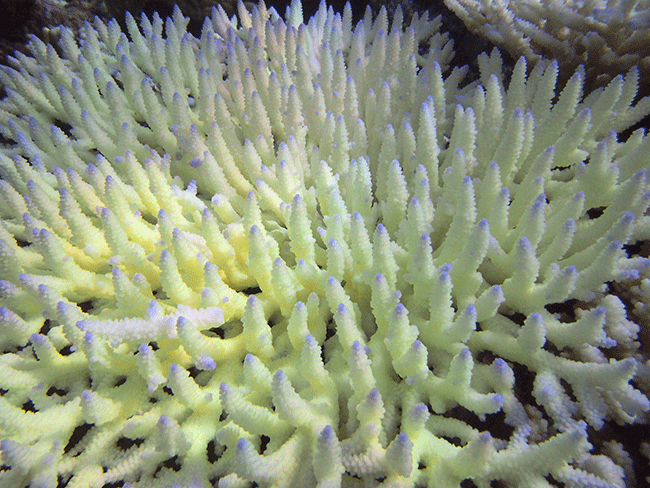
Widespread coral bleaching of the corals in the lagoon of Salomon atoll
By route of Nelson Island and the wholly submerged Victory Bank, the research vessel has now relocated from the atoll of Peros Banhos to Salomon. We’ve had the opportunity to work in a number of reef environments at this new site, from the exposed reef walls of the outer atoll to the sheltered lagoon. A keen eye easily gathers that something is awry with the corals and particularly so in the shallows and within the atoll lagoon. Rather than their characteristic honey to nut brown color, many coral colonies are turning psychedelic hues of green, yellow, blue and pink. Others are bright white. The affliction causing these abnormal colors is coral bleaching. This condition occurs when the coral animal expels the algal cells which usually live within its tissues. The algal cells (called zooxanthellae) are deeply pigmented with chlorophyll, giving a dominant green-brown color to the whole colony. The remaining coral tissue is mostly transparent, so that when the algae are ejected, the white limestone skeleton shows through. The bleached coral remains alive, for a while at least. Even heavily bleached, coral may still retain a number of the minute zooxanthellae, possibly enough to recolonize at a later date and restore the coral to health. Or, the coral may die.
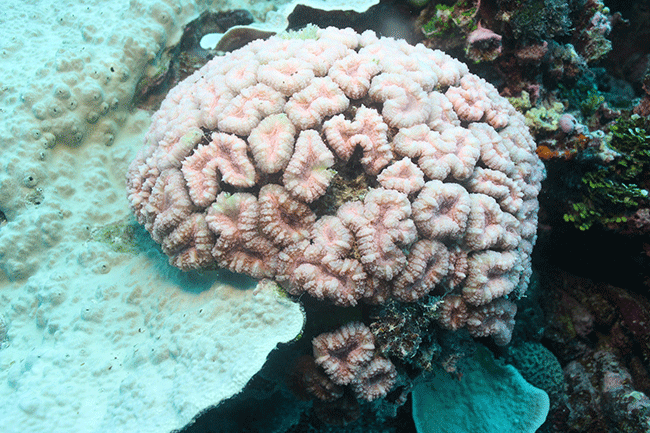
A partially bleached Lobophylla corymbosa coral turns pink in the anomalously warm waters prevailing in the Chagos at the time of writing
Several environmental factors may induce coral bleaching. As the temperature measurements we have been gathering attest to, the present cause of bleaching in the Chagos is anonymously warm water, a stress likely exacerbated by the very strong sunlight which has dominated the last weeks, with mostly cloudless skies and calm seas. While a degree of coral bleaching is reasonably common in the hot summer months, the episode developing as I write seems to be more serious. I infer this severity for two reasons. First, many corals are losing their color and second, because usually rather tolerant corals, such as Porites, are paling alongside Acropora, traditionally a less hardy species.
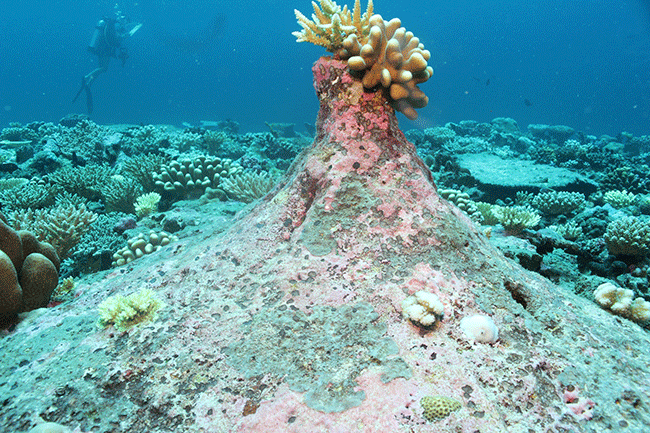
Despite the bleaching, recruitment of baby corals on to the reef remains vigorous, giving hope for a swift recovery
On the basis of my observations in the last days, I anticipate that the 2015 bleaching will be lethal for many of the corals in the Chagos, but hopefully not as severe as that witnessed in 1998 when coral reefs around the world experienced the most extensive and severe bleaching in recorded history. This die-back in the coral community is a stark reminder that despite its extreme isolation, the Chagos is not immune from environmental changes that operate globally, such as the warming of our oceans. There is a key difference, however, between the Chagos reefs and those that are not as isolated from human impacts. Out here, the overall coral ecosystem is healthy and resilient, with a great number of herbivorous fish to graze away algae that if uncropped compete with juvenile corals for space and prevent their settlement on the reef. The coral community is also diverse and dense, producing a large number of spat, baby corals, that one year after settlement on the reef can be seen as tiny colonies, so called “recruits” about the size of a quarter. The reef is littered with the next generation of corals and these recruits thankfully tend to be more resistant to bleaching than adult colonies.
With such a battery of recruits present, even if the 2015 bleaching episode serves to cull many corals from the Chagos reefs, there is a fighting chance if another hot summer does not follow in short-order, the reefs will be swiftly back on the path to recovery - just as occurred in the Chagos after the calamitous 1998 bleaching. In contrast, many coral reefs in less remote locations, those more heavily exploited by humans, failed to register a recover after 1998.
It is this resilience of Chagos reefs to global stress that makes them scientifically so interesting and ultimately why this wilderness is so precious and awe inspiring.
Sam Purkis – 4/25/2015
Coconut crabs
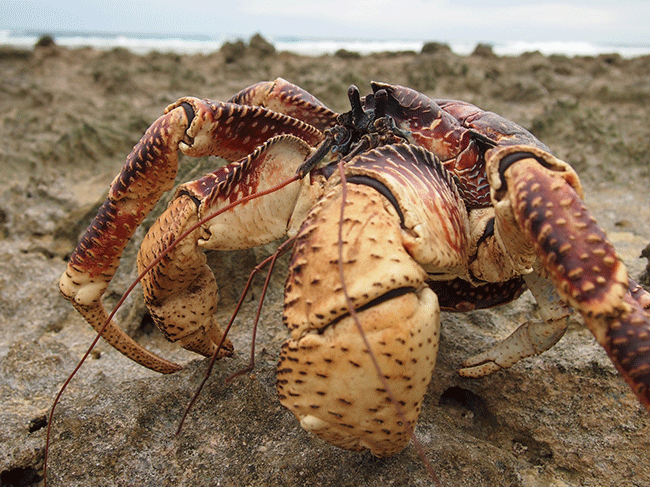
A large Coconut Crab scavenging on the reef flat
This morning I was fortunate enough to walk the coastline of Ile Manoël, the last island of Peros Banhos that I’d aimed to survey for coastline change. This mid-sized island has a particularly rocky windward reef flat which was well exposed by the low tide. I was not far on my survey before I encountered a fabulously large Coconut Crab who had ventured away from the island to scavenge across the reef flat. This handsome individual easily had a leg span of 3 ft and was one of the largest that I’ve encountered in the outer islands. The Coconut crab, part of the hermit crab family, is the largest known terrestrial arthropod and the one that I met this morning and picture below had grown to such a size that he was even too large to occupy a coconut shell – behavior that earns the crab its name.
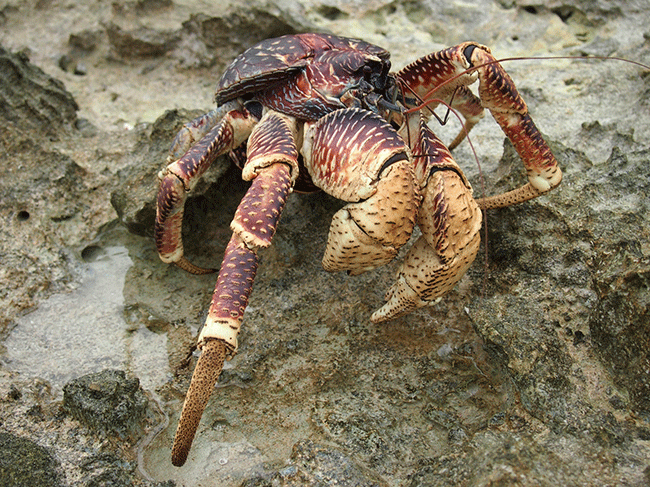
The Coconut crab, part of the hermit crab family, is the largest known terrestrial arthropod
Coconut crabs are adept at using their claws to bore into wood, and use this technique to open the nuts by boring through the eye of the nut. The crabs are reported to live to be a century old and almost exclusively inhabit the small tropical islands in the Indo-west-Pacific, including the British Indian Ocean Territory (BIOT). The crab is vulnerable to extinction, although its status on the IUCN red data list is "data deficient" as not enough is known about its distribution and ecology. In remote regions the crabs have become a valuable cash crop and are considered a delicacy. The size of this individual is testament to the protected status of the Chagos. After a handful of photographs, I left the fellow to continue his hunt for food and proceeded with my GPS survey before the rising tide erased the beach.
Sam Purkis – 4/19/2015
The first days:
This update from the Chagos by Sam Purkis, Chair of the CCT-US.
Sam Purkis in the pass between Grande and Petite Soeur surveying the coastline position.
Following-on from a record number of scientific visits this year to the British Indian Territory (BIOT), I am gratefully part of the science team for a mission led by the Khaled bin Sultan Living Oceans Foundation aboard their fabulous research vessel, the MY Golden Shadow. The research cruise is likely the last of the year in the BIOT as the weather window will shortly close. The science team assembled in Malé, the capital of the Maldives, a hot bustling atoll metropolis, the densest on the planet in fact, offshore of which the Shadow lay at anchor. We transferred directly to the ship, unpacked our gear, settled into our bunks and prepared for the 48 hour sail south to the BIOT. And smooth sailing it was. We crossed the equator without the usual ceremony and arrived into our first anchorage, the atoll of Peros Banhos, at first light on the morning of April 14th. The weather could not be more perfect, tranquil seas and hardly a breath of wind. The low-lying islands that bejewel the atoll rim of Peros Banhos vivid green with their overhanging coconut palms. Rising higher than the coconuts in the center of the islands, it’s possible to glimpse the majestic crowns of a few of the critically endangered Indian Ocean hardwood trees that dominated this area before they were cut in the 1800s to make way for the coconut plantations.
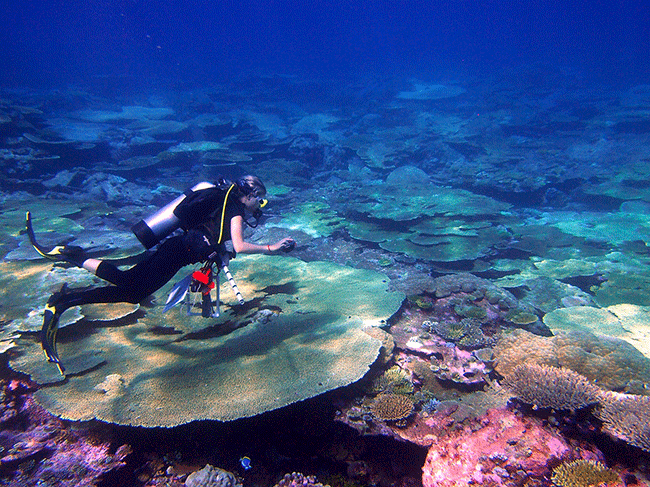
The corals of the Chagos. Perhaps the healthiest on the planet.
Our first anchorage was adjacent to Ile du Coin, a 4 km long island on the southwest corner of Peros Banhos. One thing was missing from the idyllic scene, however; the seabirds. Ordinarily, the islands of the Chagos should host abundant bird life and serve as an important nesting area in the central Indian Ocean. The dense mono-specific stands of coconut trees do not provide ideal nesting locations for birds, though Noddies and Fairy Terns will nest on the fronds. The problem is not habitat, though, rather it is the human-introduction of black rats to these islands. As a general rule, ground nesting seabirds have limited defense mechanisms to counter predators and therefore avoid or breed in low densities on islands where rats are present. Beyond conspicuously low numbers of seabirds, a brief walk along the beach of Ile du Coin reveals the characteristic borings of rats into the coconuts that litter the shoreline. In case there was any doubt about their presence, a large rat barreled down the beach in front of me this morning in pursuit of a ghost crab who barely made it into the surf in time to escape. De-ratting of the Chagos islands has been trialed on a limited scale with some success and while costly, the CCT-US looks to place its advocacy behind such initiatives if sufficient funds can be raised.
My principle science goal for the week that we will spend in Peros Banhos will be to gather data needed to assess the changing coastlines of the islands over the last forty years. This study is feasible following the discovery of rare archive aerial photographs of the atoll acquired by the US Navy in the early 1970’s which we will compare and contrast to recently captured satellite imagery. We succeeded in sourcing the original negatives for these vintage photographs shortly prior to leaving for Chagos, have scanned them and are now so called “ground-truthing” them. The challenge we face when extracting the position of the coastline from the archive and modern imagery alike, is that the coconut palms and other foliage have a tendency to overhang the coastline. For this reason, I’m spending the week walking the coastlines of as many of the islands of Peros Banhos as feasible with an accurate global positioning system. The aim here to precisely audit the contour of the coastline, even when it is obscured by tree crowns. My motivation for studying coastline change on the Peros Banhos is that it offers a unique opportunity to understand island dynamics in a setting unmodified by humans. I hope that the learnings from the work will allow for a better understanding of the response of low-lying coral islands in general to sea-level change.
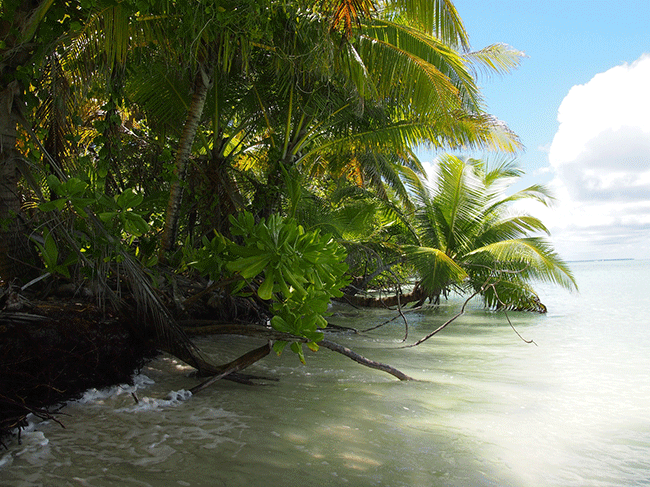
High tide on Ile Grande Soeur highlights the susceptibility of the Chagos islands to sea-level rise. Here the coastline is undercut and in the process of being lost to the Indian Ocean
I regret that the satellite slated to provide our Internet in the central Indian Ocean has failed with the result that we have limited bandwidth and at the moment I’m unable to send photographs. I will as soon as our connectivity improves.
In closing this update, I sincerely thank all the backers of the CCT-US for supporting conservation of this incredible marine wilderness. The Kayne Foundation, The Schnormeier Foundation and The Max and Victoria Dreyfus Foundation, and of course the CCT-US members. And lastly, I have immense gratitude to the Khaled bin Sultan Living Oceans Foundation for facilitating this trip to the BIOT. I’m privileged.
Sam Purkis – 4/16/2015

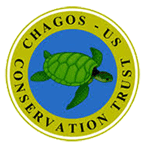 Chagos Conservation Trust – US
Chagos Conservation Trust – US